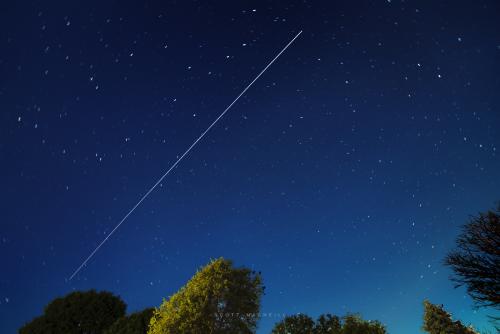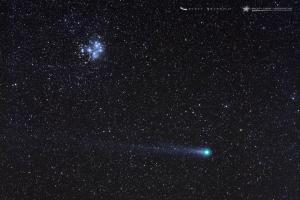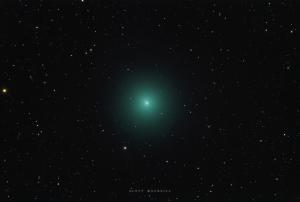Celebration of Space - January 17, 2020

The International Space Station (ISS) passes over the Rhode Island evening sky. Credit: Scott MacNeill
Starting tomorrow evening, Saturday, January 18, 2020, the International Space Station (ISS) will return to the evening skies over the USA, specifically the Northeast, offering up visible passes nearly every night through February 10th. Though notable passes will not begin until Monday evening, January 20, 2020. The ISS continues to be humanity’s only continuously inhabited space-based residence, which currently hosts the Expedition 61 crew comprised of six crew members. Observing the ISS passing over head requires a clear enough sky, darkness, and for the station to be passing overhead while still in sunlight. Being that the ISS orbits Earth inclined 51.6° to Earth’s equator, these viewing requirements are not always met, resulting in periodic views of the ISS, either in the evening, pre-dawn morning, or not at all. Here are the most notable passes for this week, the ones you don’t want to miss:
Jan 20 at 6:35 pm, starting in the SW, rising to 64° before entering orbital sunset
Jan 21 at 5:47 pm, starting in the SSW, rising to 40°, heading towards the ENE before entering orbital sunset
Jan 22 at 6:36 pm, starting in the WSW, rising to 43° before entering orbital sunset
Jan 23 at 5:48 pm, starting in the WSW, rising to 70°, heading towards the NE before entering orbital sunset ← Awesome Pass!
Set your alarm or put these times on your calendar and catch all notable passes this week. Check out our article on viewing the International Space Station, and catch up on what’s happening with the station. Keep in mind that these pass times are specific for Southern New England, and are acceptable for the Northeast. You can also get daily pass times for notable satellites, including the ISS, for the same region on the Frosty Drew Observatory website. For pass times specific to your location, visit NASAs Spot the Station. Now get out and catch an unforgettable view of the ISS orbiting over our region.
Every year, during the December – January time frame, we usually get a pretty decent comet to view. Though not a comet necessarily as awesome as Comet C/1995 O1 Hale-Bopp (the first comet I remember), but still good enough to view in telescopes, binoculars, and of course to image. Last year during this period we had the fabulous Comet 46P/Wirtanen, which offered up stunning views through the holidays. Skip ahead to this year, and it’s been a bit quiet on the comet front. Though fret not, we may have a late-to-the-show visitor, a comet that could become quite spectacular this winter-spring. Comet C/2017 T2 PANSTARS (Comet T2), has been growing brighter with each passing night and is now considered a dim binocular target (though I’m not sure I would classify it as such just yet). Currently found in the constellation Perseus, the comet is extremely well placed for observation in the Northern Hemisphere. Recent images of Comet T2 show a nice tail forming as well as a bright coma (tenuous atmosphere that forms around the comet’s nucleus, due to the comet encountering the solar wind). Comet T2 made its closest pass to Earth on December 29th, though it will not reach perihelion (closest to the Sun) until May 4, 2020, which is when it will be the most active. Though Comet T2 has a rather wide perihelion and will make its closest approach to the Sun at 1.615 AU (150,124,000 miles) distant. This could allow for excellent viewing of the comet as it approaches the Sun. Though due to Comet T2’s inclination and orbital position, we are now entering the brightest period of viewing, a period that will last past perihelion. Considering the comet is very well placed right now, we may be in the best window for views this month and next. Over the next two weeks we will continue to monitor Comet T2 while the Moon is out of the way.  If we think the comet is bright enough for easy viewing with backyard telescopes and/or binoculars, we will post finder charts to our Facebook, Twitter (@FrostyDrewOBSY) and website, as well as images that we capture! During this time the comet will be moving through the constellation Perseus and into Cassiopeia. For now, you can grab a daily star chart. If you catch a pic of the comet, share it to the Visitor Posts section of our Facebook page and we’ll share it on our timeline.
If we think the comet is bright enough for easy viewing with backyard telescopes and/or binoculars, we will post finder charts to our Facebook, Twitter (@FrostyDrewOBSY) and website, as well as images that we capture! During this time the comet will be moving through the constellation Perseus and into Cassiopeia. For now, you can grab a daily star chart. If you catch a pic of the comet, share it to the Visitor Posts section of our Facebook page and we’ll share it on our timeline.
-Scott
- Author:
- Scott MacNeill
- Entry Date:
- Jan 17, 2020
- Published Under:
- Scott MacNeill's Columns


